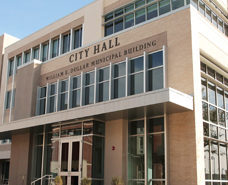The Feb. 22 City Council work session included an update on power and water outages during the recent winter storm.
Jeff Janke, Garland Power & Light’s CEO/general manager, addressed council about the power outages.
He thanked the GP&L staff for their hard work in difficult circumstances.
“Our employees have spent their entire careers dedicated to ensuring that Garland citizens are provided with reliable electricity to both their homes and their businesses,” Janke said. “And when that ability is taken away from them in a statewide event such as the one we suffered through last week, there are deep feelings of helplessness and understandable frustration.”
Additionally, he assumed responsibility and apologized for the problems and lack of adequate communication with residents. He said he believes that the distribution system could have been better designed to accommodate rotating outages.
“I commit to the council and to our customers that GP&L will conduct a thorough review of our distribution system,” Janke said. “In fact, we will be conducting an autopsy report of how our organization performed and what things need to be modified from the very top to the very bottom.”
How it happened
Tom Hancock, GP&L chief operating officer, explained what happened.
Power generated by GP&L is put out on the grid and ERCOT distributes it. ERCOT is also responsible for maintaining grid reliability. Additionally, it is their job to keep the load and generation in balance.
When balanced, the frequency is at 60 Hz. If the load is higher, the frequency decreases. If generation is higher than the load, the frequency increases. During the extremely low temperatures last week, the number dipped below 60 Hz. There were several reasons for the imbalance. They include gas supply issues, turbines icing up, frozen equipment, snow on solar panels and more.
Hancock explained that power companies must ensure that critical facilities (hospitals, nursing homes, fire stations, etc.) never lose electricity. This requires 25% of GP&L’s power.
The supply got so low that ERCOT entered their emergency alert program. When it got to the most critical point, ERCOT told the generators to shed load to avoid a blackout.
Another factor helped create the perfect storm
GP&L and other generators are required to hold back 25% of power for under frequency relays. ERCOT uses these to automatically shed load when necessary — which is when the system is consistently at a level low enough to threaten the grid’s stability. These relays, or switches, give ERCOT the ability to take 25% of the generator’s power. This begins when the frequency dips to 59.3.
GP&L has 99 distribution feeders. When the ones that were needed for critical areas plus those that had to be held back for ERCOT, there weren’t enough feeder lines to rotate power.
Janke said that they must find a way to have the ability to rotate power to customers.
This isn’t a situation that anyone thought would occur.
“None of us have ever dreamed of an event like we went through last week,” City Manager Bryan Bradford said. “It just wasn’t on our radar as something that was in the scope of possibilities.”
Water/Wastewater
Wes Kucera, managing director of Water/Wastewater Department reported problems.
The department rotated 12-hour shifts around the clock during the winter storm.
Power to one of the generating stations was lost and they had to rearrange how they ran the system. They switched pumps and pump stations to cover that deficit. Water was being pumped from the Lavon Station to cover the shortage, which was due to North Texas Municipal Water District reducing supply.
Kucera told the City Council that the system was pushed to its limits, but fared well.
There were also phone issues and residents couldn’t report problems. The call volume was five times more than usual during the storm. There were 1,705 calls.
Kucera praised the staff. In addition, he thanked residents, who when asked, did a good job conserving water.


